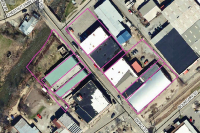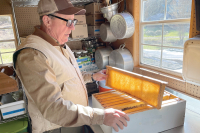Forest on fire: How much should we tamper with Mother Nature?
By Michael Beadle
For the longest time, forest fires were viewed as hazardous events to avoid at all costs.
Remember Smokey the Bear pointing his finger like Uncle Sam, telling folks to do all they could to prevent forest fires?
Now that conventional wisdom has changed.
In an effort to prevent raging forest fires in Western states like Colorado and California, the federal government spends hundreds of millions of dollars each year to burn up dry stores of timber. The controlled burns prevent dead wood from becoming kindling in the event lightning strikes or arsonists start a forest fire that otherwise might wind up destroying hundreds of thousands of acres and costing millions more in property damage.
Related Items
But how much should we nudge Mother Nature?
“That’s a good question for the general public to be asking,” said Jeff Owenby, a forester with the U.S. Forest Service.
The Forest Service is proposing two controlled burns in the Nantahala National Forest sometime between mid-February and mid-April, depending on weather conditions. One fire will burn about 175 acres on the upper portion of Old Bald near the Blue Ridge Parkway. The other will cover approximately 325 acres on Awl Knob. Both fires will be in the Little Canada community between Cullowhee and Cashiers. The reasoning for the prescribed burns, according to the Forest Service, will be for fuel reduction and to improve wildlife habitats by thinning out vegetation.
Owenby said the Forest Service is actively engaged in listening to the public and the scientific community when it comes to the issue of prescribed burns.
Hugh Irwin, a conservation planner for the Southern Appalachian Forest Coalition, believes each forest is different, and when it comes to managing America’s forests, we still don’t know the long-term consequences of prescribed fires.
“Let’s go slow,” he advises, rejecting the idea that such fires need to be lit every three to five years. “I think that is totally premature.”
What is more, Irwin argues, the federal government should not use a one-size-fits-all policy when it comes to prescribed fires. Nevertheless, Irwin and his colleagues have noticed that the federal government tends to use the Western states as a model for driving policy and funding throughout the country. Under the Bush Administration and a Republican-controlled Congress, the number of prescribed burns and funding for these fires have risen in recent years.
“It’s really ramped up in the last three or four years,” Irwin says. In fact, he adds, a lion’s share of the money has been going to Region 8, which includes Virginia, Kentucky, the Carolinas and the Southeastern states from Georgia and Florida to Texas. Nationwide, Irwin estimates the national budget for prescribed burns — along with fire safety programs and fire plans — exceeds $2 to $3 billion.
Help or Harm?
While the larger forest fires out West get big media attention, the Southeast also has a history of forest fires — some started by lightning and some started by arsonists. Of course, there’s a huge difference between an out-of-control wildfire and a much tamer, controlled fire.
Irwin agrees that Western states need prescribed burns to get rid of forest areas where dry, dead trees could serve as fuel for a potentially dangerous wildfire, but, he adds, that same reasoning doesn’t necessarily transfer to the Southern Appalachians.
“It’s so moist in the mountains [here] that you don’t really have the fuel build-up,” Irwin says. “It really is a different situation.”
Now that Congress has changed leadership with the last election, it will be important to educate the new and key legislative members about these issues, Irwin says.
Prescribed burns in the Southeast tend to be much smaller in size than the ones out West. Even so, Irwin is concerned that methods in some controlled burns — such as bulldozing lines to set perimeters for a fire — cause more harm than good to a habitat, especially when fires burn up cove hardwood areas and stream habitats that are home to rich tree species and salamanders. A more environmentally sound approach would be to use natural streams and existing roads as fire lines.
When it comes to prescribed burns, the U.S. Park Service tends to be a bit more cautious than the U.S. Forest Service, according to Bob Gale of the environmental group, Western North Carolina Alliance. That’s because of the different missions for each agency. While the Park Service has a mission of protecting its parks, the U.S. Forest Service is also in the business of harvesting trees on its lands. So, for example, if a tree stand of valuable oaks is being threatened by a less valuable species or unwanted vegetation, a controlled burn might ensure more success for harvesting those oak trees. Generally, there are not a lot of prescribed burns in Western North Carolina, and, used sparingly, they can be very beneficial, Gale said, but these fires need monitoring and careful planning to protect habitats.
“Don’t just use it for burning,” Gale said.
Fires and Biodiversity
It may sound counterintuitive, but suppressing fires can actually damage forest habitats. Left unchecked, areas that have no fires may deter certain species of trees from growing. For example, table mountain pines and yellow pines are actually fire-dependent, meaning they need the heat of fire to open their cones and burn away leaf litter to allow their seeds to take root in bare soil.
This is particularly important if a park is to maintain its rich biodiversity, according to Bob Miller, park spokesman for the Great Smoky Mountains National Park. From 1900 to 1996, there was a long-standing federal policy of suppressing fires, according to Miller, but in 1996, those guidelines changed, giving park officials the legal right to create fire management plans and conduct prescribed fires on a limited basis. Any prescribed fire comes with its own funding, staff and paperwork detailing what’s to be done and why. Within the GSMNP, prescribed fires have ranged from a few hundred acres to 3,000 acres.
This year, the Great Smoky Mountains National Park plans to have at least three prescribed fires, according to Miller. Two of the fires will be on ridges around Cades Cove — about 850 acres of Gregory Ridge and another 1500 acres along Stony Ridge and Arbutus Ridge. The other fire will re-burn some 500 acres along Wash Ridge near Cataloochee Valley. The Wash Ridge area was burned in 2004 to make room for grasses and low-growing vegetation that appeal to elk, which have become a huge attraction in the park.
The prescribed fires also helped foster regeneration of black and scarlet oaks, chestnuts and hickories, Miller said. Rhododendron and evergreens were crowding out the hardwoods there, so the fires help let other trees flourish.
The prescribed fire at Wash Ridge was initially planned for December, but weather conditions have delayed it until at least February, according to Miller.
Park officials have to wait until just the right time when it’s not too wet, not too dry, not too warm and not too windy. The vegetation has to be dry enough to burn, but not too dry or windy for a controlled fire to spread out of control.
“There’s a window,” Miller said.
And that window for prescribed burns is generally from February through mid-May or during the natural fire season from October through December (months when lightning strikes may ignite natural-causing fires).
Federal and national wildlife agencies help set and control the fire, using perimeters of streams and roads to help contain it. A fire department might come in to assist where a building may be close by, just for extra precaution.
In order to create a gradual burn, fires are lit from the top of the ridge down, rather than from the bottom up, Miller said. This imitates the pattern of a natural lightning-strike fire. A fire tends to spread out of control when it goes up a ridge, especially if it’s on a south-facing slope where the sun can heat kindling.
Ideally, a standard prescribed fire starts in the morning and ends by the evening. Larger fires might last two to three days. And if all goes well, there’s not much to see.
“You shouldn’t have anything to do if it burns the way it’s supposed to,” Miller said.









